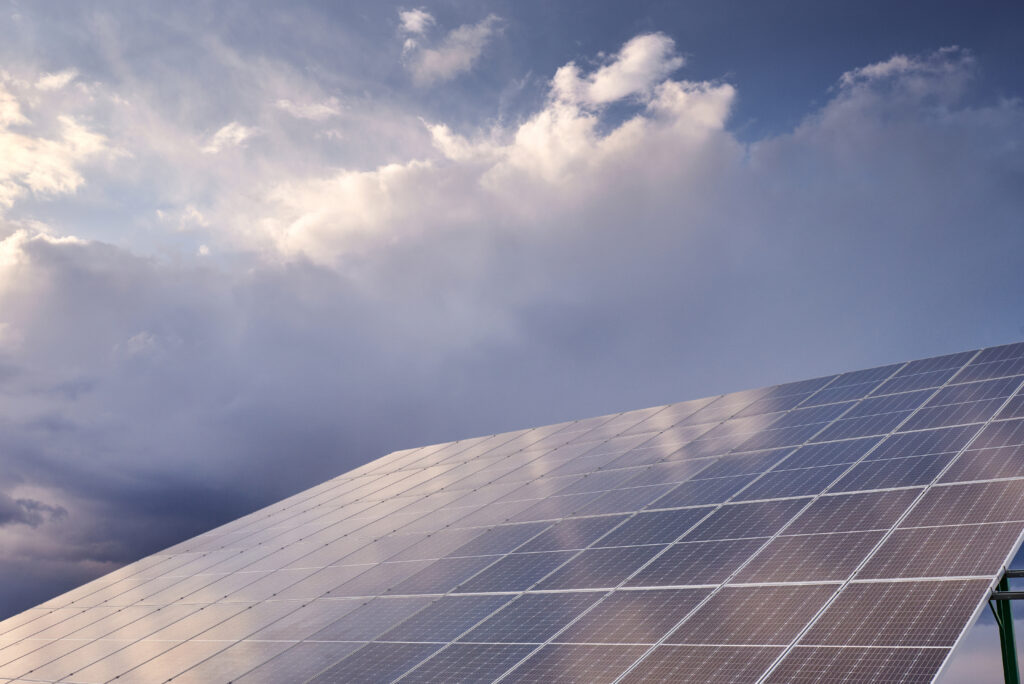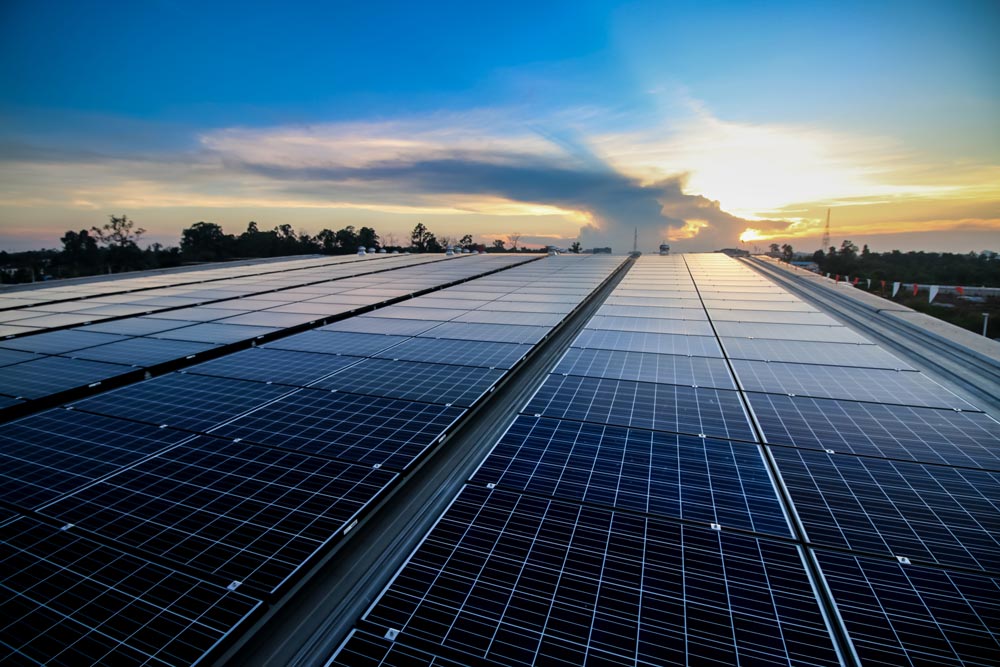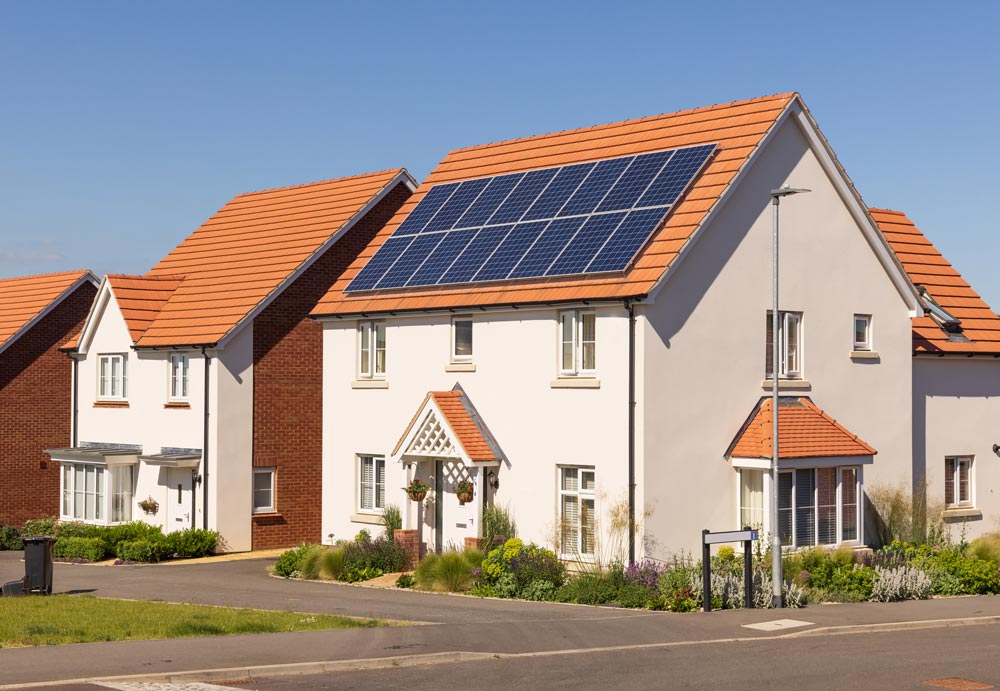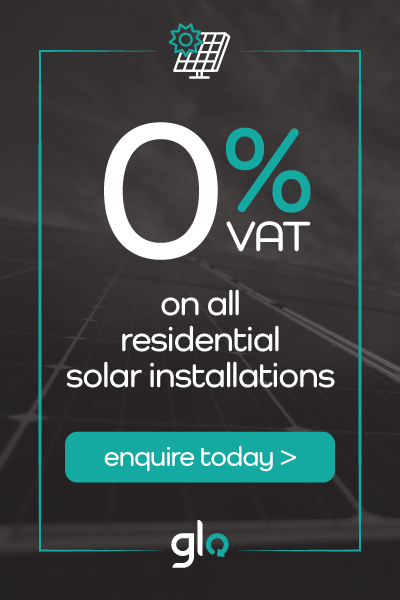Do solar panels work on cloudy days? The answer might surprise you. Modern solar systems continue generating electricity even when clouds cover the sky, typically producing 10-25% of their normal output during overcast conditions.
Many homeowners believe solar panels require bright sunshine to function effectively. This simply isn’t true. Solar panels capture both direct and scattered sunlight, making them far more adaptable than most people realise. Parts of southern England actually receive solar radiation levels comparable to regions in Spain and Germany. Your panels will continue working through cloudy weather, though at reduced efficiency.
Even during heavy, overcast, or rainy conditions, you’ll still see electricity generation from your system. Rain brings an unexpected bonus too – it naturally cleans your panels, helping maintain their performance.
This guide reveals exactly how solar technology works without bright sunshine, the performance you can realistically expect during typical British weather, and proven methods to maximise your system’s output throughout the year. Whether you’re weighing up solar installation or already generating clean energy at home, you’ll learn the facts about solar performance in our famously changeable climate.

How Solar Panels Work Without Direct Sunlight
It’s a common myth that solar panels only work when the sun’s blazing – but that’s far from true. Modern solar technology is designed to capture both direct sunlight and ambient light, meaning your panels will still generate electricity even on cloudy or overcast days (which, let’s face it, makes them perfect for the UK).
While panels produce the most power in full sun, they don’t shut off when it’s gloomy. They simply generate a bit less – often 10–25% of their peak output, depending on cloud cover. Thanks to advances in photovoltaic tech, even dull days can keep your home ticking along on clean, green energy.
Photovoltaic cells and daylight absorption
Photovoltaic (PV) cells form the heart of every solar panel. These cells capture light particles called photons, which strike the semiconductor material – usually silicon – inside each cell. This contact transfers energy to electrons, creating an electric current. What makes this process remarkable is that PV cells respond to the entire spectrum of visible light, capturing both direct sunshine and indirect light.
Your panels can absorb various wavelengths of light, including those that penetrate cloud cover. Think of it this way: if you can see your shadow outdoors, your solar panels are receiving enough light to generate electricity.
Why heat and direct sun are not essential
Here’s where many people get confused – solar panels depend on light energy, not heat, to produce electricity:
- Cooler temperatures actually boost panel efficiency
- Crisp, sunny winter days often generate more power than scorching summer ones
- Panel efficiency drops roughly 0.5% for every degree above 25°C
This distinction matters tremendously. Your panels convert photons into electricity regardless of temperature. Even when clouds reduce available light, your system keeps working, typically generating between 10-25% of their rated capacity during overcast weather.

Do solar panels work without sun?
Your solar panels need light to function, but not necessarily direct sunlight. Cloudy days still provide diffused light – sunshine scattered by cloud cover, fog, or atmospheric particles.
Panels generate electricity from dawn to dusk, whether or not you can actually see the sun. Heavy cloud cover reduces efficiency, but modern solar panels still produce electricity even under these conditions.
Rain offers an unexpected advantage. While it blocks some sunlight, it cleans your panels by washing away dust and debris, helping maintain peak performance. Occasionally, clouds create the “Edge-of-Cloud effect” – when breaks in cloud cover briefly concentrate sunlight onto your panels, sometimes producing more energy than a completely clear day.
This reliable technology means your solar investment continues delivering clean energy throughout Britain’s unpredictable weather patterns, making it a sound choice despite our frequently cloudy skies.
How well do solar panels work on cloudy days?
Solar panel performance during overcast conditions depends on several key factors. Understanding these variables helps you set realistic expectations for your system when British skies turn grey.
Typical output range on overcast days
Cloudy weather creates varying levels of energy production depending on cloud density. Research shows clear patterns in how different cloud types affect your system’s power output:
- Light cloud cover reduces production by roughly 24%
- Heavy, thick clouds can cut output by up to 67%
Put simply, a standard 6kW home system might generate 15-21 kWh during partial cloud cover, compared to 30 kWh on a bright summer day. Your panels keep working, just at a gentler pace.

The Edge-of-Cloud effect explained
Here’s something interesting – partially cloudy days sometimes deliver unexpected power boosts. The “Edge-of-Cloud effect” happens when sunlight streams through gaps or around cloud edges.
Water droplets within clouds can actually magnify and reflect sunlight back onto your panels, creating brief surges in solar radiation. These moments can push your system’s output beyond what you’d see on completely clear days. Mother Nature’s way of giving you a pleasant surprise.
Impact of cloud thickness and time of day
Cloud density makes all the difference to your panels’ performance. Thin, wispy high clouds might only reduce output by 20-30%, while dark storm clouds can slash production by over 90%.
Time matters too. Your panels work hardest during midday hours when the sun sits highest, regardless of cloud cover. Winter brings its own challenges—output typically drops to around one-eighth of the typical June day generation due to shorter days and lower sun angles.
Do solar panels work on cloudy and rainy days?
Rain doesn’t stop your panels from working. They continue producing electricity at levels similar to light cloud conditions. Plus, rainfall brings a maintenance bonus – it naturally washes dust and debris from your panels, helping preserve their efficiency.
Even during heavy downpours, your system can still generate 10-20% of its peak capacity. This reliable performance explains why solar installations thrive in famously wet cities like Seattle and Portland. British weather needn’t dampen your solar ambitions.
Ways to improve solar performance in cloudy weather
Getting the most from your solar system during overcast conditions comes down to smart choices and consistent care. Several proven strategies can help your panels deliver better results, even when British weather isn’t cooperating.
Choose high-efficiency solar panels
When selecting panels for cloudy conditions, monocrystalline panels with half-cut cells offer the best performance. The efficiency rating becomes particularly important when available light is limited:
- Maxeon’s X-Series delivers the highest residential efficiency at 22.7%
- Panasonic’s EverVolt series reaches 22.2% efficiency
- REC Alpha panels achieve 21.7% efficiency
- LG’s NeON R and Silfab Elite panels provide 21.5% and 21.4% efficiency respectively
- JA Bi-Facial Solar Panels Achieve 22.5% efficiency
These premium panels feature advanced cell technology that captures scattered and diffused light more effectively, maintaining stronger output when conditions aren’t ideal.
Optimise panel angle and orientation
Proper positioning makes a significant difference to energy collection throughout the year. While many installers suggest matching your latitude, cloudy day performance actually benefits from a slightly flatter angle. Here in the UK, south-facing panels with the correct tilt angle capture the maximum available light.
Consider seasonal adjustments too – steeper winter angles can boost performance whilst helping snow slide off naturally.
Keep panels clean for better light absorption
Regular cleaning can boost energy production by around 15%. This becomes even more critical during low-light periods, when dust and grime have a greater impact on performance than they would in bright sunshine. Fortunately, our frequent rainfall does much of this work naturally, washing away accumulated dirt and maintaining efficiency.
Use solar batteries to store excess energy
Adding battery storage changes how you use solar power during challenging weather. Store the surplus electricity your panels generate during brighter periods, then draw on this reserve when cloud cover reduces production. This approach ensures consistent power availability even through extended periods of poor weather.
Do portable solar panels work on cloudy days?
Portable panels continue working in cloudy conditions, thanks to their ability to capture various light wavelengths, including infrared and ultraviolet radiation that penetrates cloud cover more readily than visible light. For best results, face portable panels south and adjust the tilt angle based on your location.
What to expect in UK winters and low-light seasons
Winter brings specific considerations for solar panel owners across Britain. Knowing what to expect during these shorter days helps you plan effectively and set realistic goals for your system’s seasonal performance.

Do solar panels work in winter?
Solar panels remain operational throughout winter months, though output does drop significantly. Research indicates winter production typically falls by up to 80% compared to summer generation. A 4kW system producing 15-20 kWh daily during summer might only deliver 3-6 kWh in winter. However, your panels will still contribute meaningful electricity even during December’s shortest days.
Shorter days and lower sun angle
Reduced daylight hours create the biggest challenge for winter solar generation:
- British summers provide up to 16 hours of daylight
- Winter days shrink to 8 hours or less
The sun’s path sits much lower in winter skies, forcing sunlight to travel through more atmospheric layers before reaching your panels. Combined with Britain’s increased winter cloud cover, this significantly reduces energy capture during December and January.
Cold weather and panel efficiency
Winter weather creates an interesting paradox for solar performance. While shorter days limit generation time, cooler temperatures actually boost panel efficiency. Solar panels work best between 5-25°C, gaining roughly 0.5% efficiency for every degree below 25°C.
Snow concerns many homeowners, but it rarely halts production completely. Light passes through thin snow layers of 2-3 inches, and most British installations naturally shed snow thanks to their tilted mounting. Snow can even help performance through reflection – bouncing extra light onto your panels via the albedo effect.
Do solar panels work on cloudy days in the UK?
During British winters, solar panels typically produce around 20-30% of their peak summer capacity. Actual output depends on your panel positioning, local weather patterns, and any shading issues. Encouragingly, research shows panels can still achieve up to 80% of maximum output on partially cloudy winter days. This makes battery storage particularly worthwhile during these lower-generation months.
Conclusion
Solar panels work remarkably well on cloudy days, dispelling the common myth that bright sunshine is essential for electricity generation. Modern systems continue producing power throughout overcast conditions, maintaining 10-25% of their normal output when clouds fill the sky.
Your solar installation proves its worth regardless of British weather patterns. Rain keeps panels clean naturally, whilst cooler temperatures actually boost efficiency. Those unexpected power surges during partly cloudy conditions show just how adaptable this technology really is.
Winter months bring reduced output – around 20-30% of summer generation – but this stems from shorter days rather than cold weather. Your panels keep working steadily through the darkest months, contributing to your energy needs and reducing bills.
Smart choices make all the difference. High-efficiency panels capture more diffused light, proper positioning maximises available daylight, and regular maintenance ensures optimal performance. Battery storage transforms how you use solar energy, providing power when generation drops.
Solar power delivers reliable, sustainable energy for UK homes despite our unpredictable climate. Rain or shine, summer or winter, your panels work consistently to cut energy costs whilst reducing environmental impact. This proven technology continues earning its place on British rooftops, delivering clean energy and genuine savings year after year.
Frequently asked questions about: Do Solar Panels Work on Cloudy Days?
How effective are solar panels on cloudy days?
Solar panels continue to work on cloudy days, typically producing 10-25% of their normal power output. The exact efficiency depends on the thickness of cloud cover, with performance ranging from 80% on partially cloudy days to about 33% during heavy overcast conditions.
Do solar panels function during winter in the UK?
Yes, solar panels work throughout UK winters, though with reduced output. Winter production typically decreases by up to 80% compared to summer months due to shorter days and lower sun angles. However, cooler temperatures can actually improve panel efficiency.
Can solar panels generate electricity from moonlight?
While solar panels can technically produce some electricity from moonlight, the output is minimal. On a clear night with a full moon, panels might generate only about 0.2-0.3% of their normal daytime production – Impressive though!
How can I improve my solar panel performance in cloudy weather?
To enhance solar performance in cloudy conditions, consider using high-efficiency panels designed for diffused light, optimise panel angle and orientation, keep panels clean, and use solar batteries to store excess energy from sunnier periods.
Do solar panels work better in cold or hot weather?
Contrary to popular belief, solar panels often perform better in cooler temperatures. They operate most efficiently between 5-25°C, with efficiency increasing by approximately 0.5% for every degree below 25°C. This means cold, sunny days can produce more electricity than hot days.



![Why Solar Panels for Farms In Devon Are Better Than Traditional Energy [2025 Guide]](https://glo-renewables.co.uk/storage/2025/08/Why-Solar-Panels-for-Farms-In-Devon-Are-Better-Than-Traditional-Energy-2025-Guide.jpg)


